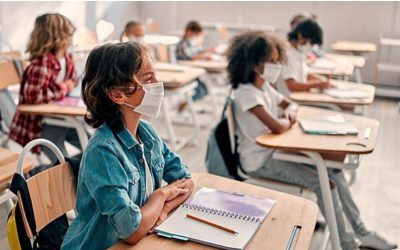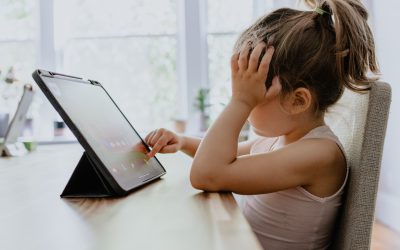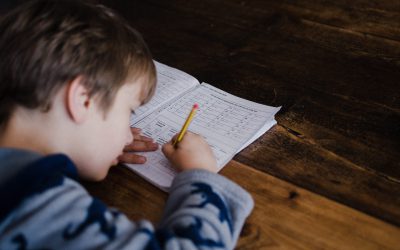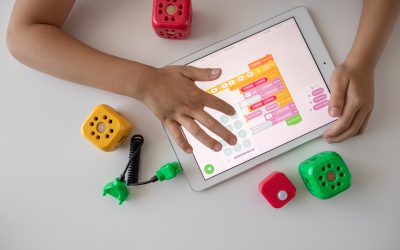COVID-News update April 13 – April 17
20 Apr 2020 | News
On Friday 17 April, we discussed the week with Astrid Ottenheym (director of the network for inclusive primary education in Noord-Kennemerland), Mariska Westdijk (Director of Education & Identity of school board CSG De Waard) and Dorine Wiersma (Information manager national Parent Association ‘Ouders en Onderwijs’).
We talked about current good practices that should be sustained when schools re-open:
- Renewed education partnership between parents and teachers
- Flexible school day to accommodate students’ various competences and capabilities (also allowing for a combination of in-school and online learning).
Prof. Dr. Melanie Ehren & Rukiye Turkeli
14-04-2020


In the national and international news this week: reopening of schools with the example from Denmark and initial experiences, three scenarios from the World Bank on potential learning loss, 5-steps in planning of education systems from McKinsey, concerns over workload of teachers and students’ mental health.
Good practices of home-schooling and distance learning
We discussed the good practices that have been developed and how these should be sustained when schools re-open:
Parent-teacher partnership
The current context of home-schooling and online teaching has changed the partnership between parents and teachers where both now have a better understanding of each other’s role and have more insight into each other’s work and situation. Teachers see, for example via a video connection, what the home situation is like for a student and have more contact with parents. The possibilities for online contact and conversations offer opportunities to schedule conversations with parents more easily, for example at times during the working day, which will also make it easier for both parents (also when parents are divorced) to more easily join parent-teacher conferences.
Parents are now gaining more insight into their child’s educational learning process and how education is offered. They see what subject their child is expected to cover and how it is expected to learn. They also better understand what their child is interested in and how it learns best. As the emphasis in parent-teacher conversation has mostly been on learning outcomes and behaviour in class, these understandings are new and parents only now appreciate the learning process of their child. As Dorine Wiersma describes:
“I am really only now aware of what my children are learning in the classroom. I found it difficult to find out which teaching methods were used, the structure of their school day, how fast and how slow they learn certain content, which subject matter they find interested and are intrinsically motivated to learn, and what they don’t find interesting, etc. I didn’t know that before as conversations with the teacher were more about ‘how they behave in class’, ‘what are the learning results’. Now the focus is much more on the educational learning process as you need to understand this to be able to teach your children at home. ”
Coordination of home education and regular education; roles of parent and teacher
For the future, consideration can be given to how parents can better support their child at home and how parents can be supported in helping their children with schoolwork. An important point of attention here is that not all parents are equally capable of teaching their child at home (for example, when they are not fluent in the Dutch language); In addition, a good understanding of teacher versus parent roles is important where parents are primarily care takers and support the learning process, rather than being responsible for teaching and assessment.
Such understanding of roles is also crucial in the current context of home-teaching. There are examples where this is not working well, such as when parents assume a controlling role of “police officer” in instructing their children, this can destroy their children’s motivation and confidence.
It is the school’s and teacher’s responsibility to provide for quality education, which implies that assessment of learning progress needs to be done by the teacher, for example by taking a timed word test via a live connection.
Another suggestion was to also particularly use formative assessments when schools are closed, and choose assessment formats which allow for reflection and which motivate children to continue learning, such as portfolio assignments.
More flexibility in a school day
In the current situation of home-schooling, students have more autonomy and flexibility in a school day. Some children flourish because they can pace their day, or alternate listening and seated activities with physical exercise. The flexibility to vary online and face-to-face instruction and exercise, and to differentiate instruction for low and high-performing learners through online activities and material is a valuable practice to build into regular schooling.
From the national and international news
Scenario’s for education systems and schools
On the 16th of April 2020 McKinsey hosted a webinar where they presented a five-step model of how education systems can plan to move through the current crisis: from resolve, resilience, return, reimagine, to reform. They explained how most systems are now in the second phase (offering remote learning and organizing support for students in vulnerable situations) and moving to the return phase where schools reopen. Next steps need to capitalize on current learning and good practice where we reimagine what education should look like and reform education systems where relevant.
Re-opening of schools
Schools in the Netherlands have been closed since March 16. Government will decide Tuesday the 21st of April if, when, and how schools will re-open. A survey of teachers (n=5.000 last week however indicated wide-spread concerns over re-opening where teachers feel they can’t meet the guidelines for social distancing in schools (narrow corridors, too small classrooms etc). Survey responses also indicated that 42% of teachers in primary education, 37% of teachers in secondary education and 53% of teachers in special needs think that children at risk and from disadvantaged backgrounds should have priority to access in-school learning when a phased approach is chosen. 3/4th of teachers are not in favour of combining distance learning and in-school teaching as it would lead to too high workload.
Arguments for reopening schools are: school closure only has a minor impact (estimated 2-4%) on reduction in the spread of the virus; opening schools will limit adverse effects on the economy as parents can start working again, opening schools reduces possible further learning loss.
The schools in Denmark have been open again since Wednesday 15 April for all children up to 11 years old. Schools were asked to decide for themselves how to manage 2 meter distance between pupils, splitting classes in two with one teacher for 10 or 11 students, sending pupils outside as much as possible, even for classes, allowing pupils to only play in small subgroups with peer from their own class, or allocating some students a shorter school day to allow others to access resources at different times. Over 90% of pupils are back in their own school, but a Financial Times report (18 April 2020) also says that a number of parents keep their child at home or have chosen a school in a more remote and sparsely populated location away from the capital. Some concerned Danish parents have opened a Facebook group ‘My kid should not be a guinea pig for Covid-19’.
In France and Austria, schools will open again at least after mid-May. Schools in Belgium will probably remain closed until May. In Germany, schools will reopen gradually after May 3, with priority for exam classes and highest classes of the PO. There is still a clear plan to come. Schools in Italy will remain closed until the new school year and schools in England will also be closed for the time being. Teachers in England have asked to stop speculating on a date and to come up with a clear plan before opening the schools.
Remediating learning loss
Last week, the Dutch national Education Council (an advisory body to government) advised on measures to remediate potential learning loss once school re-open:
- First, assess potential learning loss to understand what measures need to be taken. In case there is learning loss, remedies can include:
- Shorten the summer holiday when schools are going to be closed throughout May and potentially longer.
- Organize summer schools for children from disadvantaged backgrounds
- Extend the school day and offer after-school teaching for learners who need to catch-up, providing support in home-work, or socio-emotional development of students.
Responses to the advice where not overly positive, criticizing the emphasis on learning loss (instead of wider skills students may have developed); suspending the summer holiday was also critiqued as teachers, parents and students are currently already experiencing a high workload and need a break over the summer.
Scenarios learning loss
The debate about potential learning loss also features internationally with possible scenario’s summarized by the world bank:
- The first is a reduction in average learning levels across the distribution.
- The second is a flattening or skewing of the learning curve due to highly unequal effects of the crisis. This is a scenario in which children who are at the top will pull ahead, while students at the bottom fall further behind.
- A third scenario is where the curve changes due to drop-out of learners who permanently leave school (e.g. girls in developing countries, or children from working class families who go into earlier employment and don’t return to school.
Workload of teachers
The survey of teachers in the Netherlands (by the AOb) indicates that 70% of teachers experience a higher workload than usual. This is particularly concerning as workload was already high due to teacher shortages before the crisis.
In England, teachers are massively sharing wish lists on Twitter using the hashtag #spreadkindness. Teachers buy presents from these lists for fellow teachers, to support each other morally during this period with extra workload:
Socio-emotional well-being of students
Closing schools, reduced / no contact with family and friends, fear of your own health and that of your loved ones has a huge impact on students’ mental health, which is essential for the learning behavior and development of the child. Students’ learning and mental health is also affected by parents who experience stress from job loss or financial insecurity. The Dutch national Education Council advices schools to monitor the social-emotional development of children; for example by having purposeful brief daily conversations about how they are dealing with the crisis.
Research among 2.000 students in the UK shows that 83% of students experience mental health issues from the Corona virus pandemic. Students indicated that (face-to-face) online contact with friends and classmates helps, as well as physical activities and watching movies together. Many examples of initiatives to promote sports at home can be found on the Internet:
- Teachers who perform online sports exercises with their students.
- Online gym class developed by The Hague University of Applied Sciences so that children can exercise independently at home: YourTurn @ Home.
First minister Nicola Sturgeon of Scotland has announced an online application for children. This application called “Mind Yer Time” aims to teach children about healthy screen use and doing school work online. She believes that more attention should be paid to the impact of working online on children’s mental health.
In Spain, where strict lock-down measures have been in place, the Ministry of Health is looking into ways to relax some of these measures to allow children to play outside.
Sources
https://www.tes.com/news/coronavirus-teachers-exchange-gifts-boost-morale
https://www.onderwijsraad.nl/publicaties/adviezen/2020/04/16/gevolgen-coronamaatregelen
https://nos.nl/artikel/2329922-cao-akkoord-in-voortgezet-onderwijs-ruim-3-procent-loon-erbij.html
https://www.tes.com/news/coronavirus-stop-speculation-about-schools-reopening
https://www.aob.nl/wp-content/uploads/2020/04/Samenvatting-enquête-afstandsonderwijs-14042020.pdf
https://www.aob.nl/nieuws/aob-bezorgd-over-risicos-bij-opening-scholen/
https://www.kennisnet.nl/artikel/7977/kennisnet-zoom-gebruiken-kies-een-veiliger-alternatief/
https://www.tes.com/news/how-rocketing-unemployment-damages-childrens-education
https://www.tes.com/news/colleges-must-collaborate-protect-mental-health
https://www.thelancet.com/journals/lanchi/article/PIIS2352-4642(20)30109-7/fulltext
https://www.tes.com/news/sturgeon-monitors-nations-where-schools-may-reopen
https://nivoz.nl/nl/geen-leerachterstand-maar-een-nieuwe-beginsituatie
See also information for:
Most recent blogs:
How LEARN! supports primary and secondary schools in mapping social-emotional functioning and well-being for the school scan of the National Education Program
Jun 28, 2021
Extra support, catch-up programmes, learning delays, these have now become common terms in...
Conference ‘Increasing educational opportunities in the wake of Covid-19’
Jun 21, 2021
Covid-19 has an enormous impact on education. This has led to an increased interest in how recent...
Educational opportunities in the wake of COVID-19: webinars now available on Youtube
Jun 17, 2021
On the 9th of June LEARN! and Educationlab organized an online conference about...
Homeschooling during the COVID-19 pandemic: Parental experiences, risk and resilience
Apr 1, 2021
Lockdown measures and school closures due to the COVID-19 pandemic meant that families with...
Catch-up and support programmes in primary and secondary education
Mar 1, 2021
The Ministry of Education, Culture and Science (OCW) provides funding in three application rounds...
Home education with adaptive practice software: gains instead of losses?
Jan 26, 2021
As schools all over Europe remain shuttered for the second time this winter because of the Covid...






